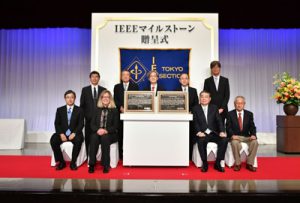[June 10, 2016]
The 2016 Second Lecture of Tokyo Section
The 2016 2nd Lecture of IEEE Tokyo Section, History Committee and Technical Program Committee, was held on April 25th, 2016, at Kikai Shinko Kaikan with 32 participants.
The lecturer was Dr. Klaus Staubermann, Principal Curator, Science & Technology, National Museums Scotland.
And the talk was entitled ;
| 1, | “From Material Culture to Maker Culture : how to access technology objects in museums” |
| 2, | “The Communicate gallery of National Museums Scotland” |
IEEE Milestone Dedication Ceremony and Commemorative Lecture of Tokyo Section
[Dedication ceremony commemorative photo]
(From Left Side, Front Row):
Dr. Kazuo Hagimoto (Chair, IEEE Tokyo Section) Ms. Karen Bartleson (President-Elect, IEEE) Mr. Katsuto Momii (President, NHK) Prof. Mitsutoshi Hatori (Prof. Emeritus, University of Tokyo)
(From Left Side, Back Row):
Mr. Hidenobu Harasaki (Secretary, IEEE Tokyo Section) Prof. Isao Shirakawa (Chair, History Committee, IEEE Japan Council) Prof. Tomonori Aoyama (Chair, IEEE Japan Council) Mr. Koki Morinaga (Executive Director& Chief of Engineering, NHK) Dr. Toru Kuroda (Director, Science & Technology Research Laboratories, NHK)
●Dedication ceremony
Dedication ceremony of IEEE Milestone for “Emergency Warning Code Signal Broadcasting System” and “High Definition Television System” was held in Century Room-A at Hyatt Regency Tokyo, Japan on May 11, 2016. Ms. Karen Bartleson, IEEE President-Elect, presented commemorative plaques to Katsuto Momii, President, NHK (Japan Broadcasting Corporation).
The approved IEEE Milestones are
(1) Emergency Warning Code Signal Broadcasting System, 1985
NHK (Japan Broadcasting Corporation) began broadcasting emergency warning code signals in 1985. The system embedded signals within AM and FM radio broadcasts that provided reliable and prompt transmission of emergency warning information to the public. During the course of digital TV standardization, the warning codes were integrated into technical standards of international satellite and terrestrial broadcasting.
(2) High Definition Television System, 1964-1989
NHK (Japan Broadcasting Corporation) developed high-definition television (HDTV), a high-resolution and wide-screen television system designed to convey a strong sense of reality to viewers. Research began in 1964, ranging from psychophysical experiments to system development. In 1989, the world’s first HDTV broadcast via satellite opened a new era in broadcasting. Since 1989, HDTV has spread throughout the world.
●Commemorative Lecture
After the dedication ceremony and celebratory party, the lecture session entitled, “IEEE Milestones Memorial Lectures” was held in Century Room-A at Hyatt Regency Tokyo, Japan with 110 participants. Three lectures of the following have been made.
| Lecture 1. | IEEE Milestone Overview |
| Prof. Isao Shirakawa, IEEE Japan Council History Committee Chair | |
| Lecture 2. | Research and Development of Emergency Waring Code Signal Broadcasting System |
| Dr. Kazuyoshi Shogen, VP, B-SAT (Broadcasting Satellite System Corporation) | |
| Lecture 3 | Research and Development of High Definition Television System |
| Mr. Taiji Nishizawa, ex Director of Science & Technology Research Laboratories, NHK |
◆Picture
Notice from IEEE Tokyo Section Office
Tokyo Bulletin is published via E-mail.
- Have you renewed your 2016 IEEE membership? You can easily renew your membership online with your Web Account.
- Tokyo Section encourages membership upgrade to Senior Membership. Visit IEEE website for online application. For details, please refer to Senior Member Application procedure.
- Please make sure to notify IEEE HQ of any changes in your address etc. Online notification is available by registering your Web Account.
- IEEE Tokyo Section welcomes any comments, requests or inquiries from our members. Please send them to tokyosec@ieee-jp.org.



